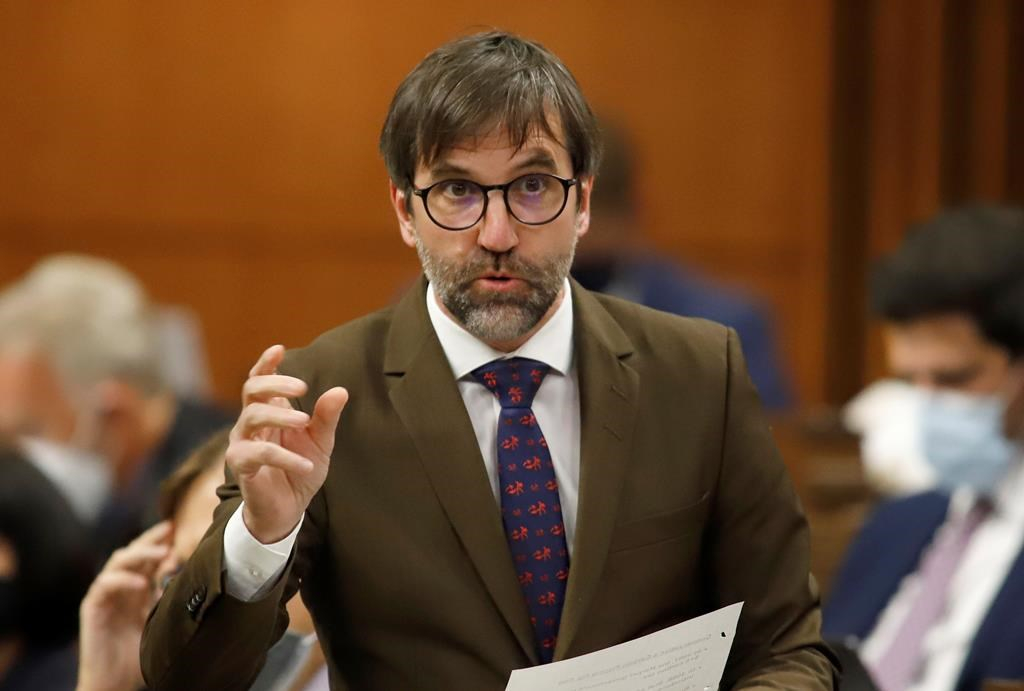Support strong Canadian climate journalism for 2025
The federal government is proposing to use an industry-specific cap-and-trade system or a modified carbon pricing system to set a ceiling for emissions from the oil and gas sector and drive them down almost 40 per cent by the end of this decade.
The two options are contained in a discussion paper Environment Minister Steven Guilbeault will publish Monday. It is the first glimpse Canadians are getting of how the Liberals expect to implement the oil and gas emissions cap promised in last year's election.
The oil and gas industry accounts for more than one-quarter of Canada's total emissions — 179 million tonnes in 2020, or about what an average car would emit driving around the equator more than 17 million times.
"We simply cannot ignore the fact that the oil and gas sector is Canada's biggest emitter," Guilbeault said in April during a House of Commons committee meeting studying the proposed emissions cap on oil and gas.
What Guilbeault didn't say then, and what the discussion paper doesn't say now, is what the specific emissions cap will be. It's supposed to start at "current levels" — which going by the data that was available when that promise was made would mean 2019 levels, or 203.5 million tonnes.
Background documents and government sources suggest the cap for 2030 will be very close to the one proposed in the new national Emissions Reduction Plan in March — 110 million tonnes. That's a 46 per cent cut from 2019 levels, and 32 per cent over 2005.
Canada is aiming to cut emissions across all sectors 40 to 45 per cent from 2005 levels by 2030.
The oil and gas sector has not had emissions that low since 1992. In the last three decades, as production of gas, conventional oil and oilsands soared, emissions from the sector have risen 83 per cent. Overall emissions in Canada are about 23 per cent higher over the same time period.
Input on the options to manage the cap will be accepted until Sept. 21 with Guilbeault aiming to unveil the final plan early in 2023.
The first proposed option involves a new cap-and-trade system on the oil and gas sector in isolation. The total emissions allowed would be divided into individual allowances which will be allocated to specific companies mainly through an auction.
Companies that don't buy enough allowances to cover their emissions will have to buy allowance credits from other oil and gas companies that bought more than they need.
The funds raised from the auction would be recycled to programs that help the sector cut emissions.
The second option would modify the industrial carbon price already applied to the oil and gas sector, possibly by hiking the price itself if needed, but with the aim of ensuring the emissions from the oil and gas industry itself fall by limiting the trading of carbon credits to the sector.
Companies can currently reduce the carbon price they pay by buying credits from others that produce less than their emissions limit. The modified plan would allow them only to buy credits from other oil and gas companies, not from other industries.
Most of Canada's oil and gas producers are already cutting emissions due to other regulations and a desire to become a cleaner, more competitive option for global customers.
That has been the Conservative party's position on the industry for years — using cleaner Canadian fossil fuels to displace dirtier ones produced elsewhere.
The industry has work to do, particularly on the oil side, where Canada's heavier oils require more energy to extract from the ground than in places like Saudi Arabia. While oilsands emissions per barrel of oil, known as the emissions intensity, is down about 30 per cent since 1990, it's still higher than many global competitors.
The Oil Sands Pathway Alliance, with six of the biggest oilsands companies on board, is aiming to get emissions to net zero by 2050, mainly through carbon capture and storage projects that trap greenhouse gases before they go into the atmosphere and then store them back underground.
The alliance, whose member companies account for 95 per cent of oilsands production, released a plan this spring aiming to cut 22 million tonnes of emissions from 2019 levels by 2030.
Company leaders have said they're not opposed to a cap, but insist it must be realistic and based on consultations with industry about what is feasible. Anything more than that would likely drive production cuts and job losses, they have argued.
But the Alliance and government remain far apart on some fundamental issues, such as determining where current emission levels actually stand. The most recent national inventory report says oilsands production and processing emissions were 83 million tonnes in 2019, but the Alliance pegs the figure at 68 million.
A government official, speaking on background because he was not authorized to speak publicly, said if the cap on emissions for the oil and gas sector comes in higher than the Emissions Reduction Plan, it will force other industries to cut more than their share or Canada won't meet its 2030 targets.
This report by The Canadian Press was first published July 17, 2022.




Comments